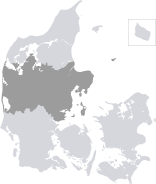Regionen er
Region Midtjylland er en offentlig organisation med tre hovedopgaver inden for velfærd og udvikling:
- Sundhed og hospitaler
- Specialiserede tilbud til socialt udsatte og handicappede
- At være en politisk drivkraft for vækst gennem regional udvikling
Regionen har omkring 26.100 fuldtidsstillinger og et budget på 30 milliarder kroner. Størstedelen går til sundhed.
Regionen bliver ledet af 41 direkte valgte politikere.
Du har måske mødt regionen
- som patient på et hospital
- på besøg hos en pårørende i behandling for psykisk sygdom
- som iværksætter med brug for rådgivning
- som passager på en regional bus
Gennem valget af politikere har borgerne fx indflydelse på
behandlinger og ydelser i sundhedsvæsenet og kvaliteten af dem.
Skottenborg 26, 8800 Viborg
kontakt@regionmidtjylland.dk
7841 0000

Regionsrådets formand
Anders Kühnau
Overblik over hele regionen
På www.rm.dk får du overblik over
hele regionen
Sundhed.rm.dk er info om sundhed til borgere og patienter
Regionens hjemmesider
Hospitaler
- Hospitalsenhed Midt
- Regionshospitalet Gødstrup
- Regionshospitalet Horsens
- Regionshospitalet Randers
- Aarhus Universitetshospital
Sociale tilbud


